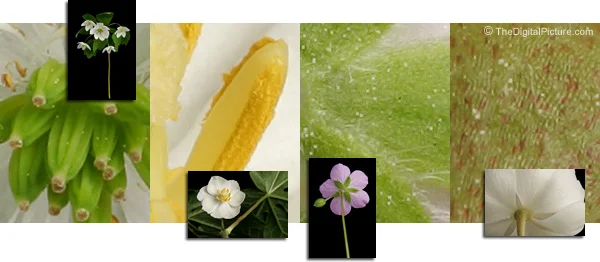Canon EOS-1D Mark II Review
The Canon EOS-1D Mark II is an EXCELLENT professional grade DSLR Body.
The clean high ISO results are what impress me the most with 1D II. Pictures are nearly noise-free up through ISO 400, ISO 800 is very good and ISO 1600 is very useable (and I am very particular in this regard). Basically, the 1D II is excellent for low light photography.
Following are some 100% crops from an ISO stress test. This crop is from a dark area near the bottom of the photo - an area showing the most noise - and certainly not showing off the 1D II's other capabilities. Noise is most clearly exhibited in dark areas of 1D II images. In these particular pictures, noise is most easily visible in the vinyl siding. Also compare the rock in each crop - There is far less noise showing there. Again, these crops do not show off the camera's abilities - they are useful for comparing ISO noise only. The ISO 200 shot appears to be slightly OOF (out of focus - and my fault). These pictures are straight out of the camera with factory default settings. A Canon EF 24-70mm f/2.8 L Lens was used - at 24mm and f/8.
 |
 |
 |
| ISO 100 | ISO 200 | ISO 400 |
 |
 |
|
| ISO 800 | ISO 1600 |
I suggest you download these ISO comparison images (crops) and roll through them in your image viewer. See what YOU think.
The noise-free results of the 1D II put to rest my biggest fear in upgrading from the Canon 10D. Canon 10D ISO 100 images are very smooth - a result I fell in love with. It didn't take much time with the 1D MKII to put this fear to rest.
The Canon 1D has been available for a long time prior its successor, the 1D II. Many regard the 1D as a better camera than the 10D - and in many ways it certainly is. However, the 1D sample images I have seen did not have the smooth result I was looking for. Also, I did not want less than a 6 megapixel image.
Now I can have my cake and eat it too.
I will leave a 1D vs 1D Mark II comparison to someone with hands-on 1D experience and will focus more on the differences a Canon 10D user will notice. Canon 1D users should be able to glean some information as well. Read on ...
Another concern a lot of people have about the 1D II regards sharpness. The 1D II is very sharp. Mark II image detail is very good - and it takes sharpening very well. Landscape photographers will especially appreciate the details captured by this camera. When comparing similar shots of distant trees and shrubs, the 1D II results have noticeably more foliage detail than the 10D.
I wanted to run an out-of-the-camera sharpness test between the Canon EOS 10D and the 1D II, but what is base 0 sharpness in each camera? I'm not sure an apples-to-apples out-of-the-camera sharpness comparison between the 10D and the 1D MK2 is possible or fair. Sharpness can be applied at various points in the image capture and processing algorithm. One camera may do more sharpening in its image capture, the other may save it for its post-processing algorithms.
Following are some 100% crop samples to show 1D II sharpness. I am not as concerned about out-of-the-camera sharpness as I am in final result sharpness; thus, these samples have been sharpened to my personal taste. Your taste for sharpening may differ from mine - many people like a more heavily sharpened picture. If that is the case with you, I suggest you download this image and apply additional sharpening - see how sharp you can make it.

The above examples were shot with the Canon EF 180mm L Lens. The 1D II was tripod-mounted with a shutter speed of 1/200 and an aperture around f/14. Lighting was from a Canon 550EX Flash fired into a Chimera Softbox.
Larger is one of the first adjectives that comes to my mind when picking up the 1D II after living with the Canon EOS 10D DSLR and Canon EOS D60 DSLR cameras for the last two years (both without the battery grip - BG-ED AKA Big Ed).
Of course, physical size is the first noticed "larger". Even with the larger size, the 1D MKII feels better in my hands than the 10D. The camera is not thick to grip, but is tall in your hand. The tactile feel is very good - grippy. The 1D Mark II is also heavier, but that seems to help keep it steady when shooting.
The viewfinder is another 1D II "larger" feature. The bright and large viewfinder is a welcome upgrade (but nothing new to 1D owners). No more guessing what is in the picture that I can't see in the viewfinder. This feature actually took some time to get used to - I became proficient at capturing a part of an image outside of the viewfinder on the 10D. I now have to unlearn this skill.
The 1D II's image review LCD is larger also. Going from 1.8" to 2.0" seems larger than the stat suggests. I'm sure increasing the pixel count from 118,000 to 230,000 is noticeable. The shot image shows on the display very fast after the shutter release. You have to look fast to see a 2 second display. You'll get less nose oils on the display since the eyecup is set back farther than on the 10D.
One larger that I did not like was the price. I'm almost over that.
Faster is another pertinent adjective.
The 1D II's shutter release is faster - almost instantaneous. The release is very smooth - kicking off an also-fast "ka-chunk" of the shutter. I would call the 10D's shutter a "click-click", but the 1D MKII has a "ka-chunk". The "ka-chunk" is not that loud and really is fast. Want to hear something fun? Listen to a 8.5 FPS burst ...
Canon EOS-1D Mark II 8.5 FPS Burst
Canon EOS-1D Mark II Single Shots
The 1D II powers on almost instantly (.5 seconds). Menu functions are more snappy as well. No more waiting.
The continuous shot rate of the 1D II is a fast 8.5 fps for 40 shots (20 shots RAW - CR2). You can practically shoot video. OK, not quite - but this is the fastest AF DSLR at this time - and capturing 8.2 Megapixels each shot. CompactFlash/SD memory cards can be filled in a flash.
More is another favorite 1D II DSLR adjective.
First, there are more megapixels. And who doesn't love megapixels? Of course, the size of your images will beg for more storage capacity and more computing resources for your postprocessing. A resulting 16-bit TIFF file tips the scales at about 48 MB.
You have your choice of CompactFlash or SD Cards. Or you can use both - even at the same time (for redundancy). The rear-loading card slots are much easier to see with the camera hanging from its neckstrap than the 10D's side-loading card slots. They are also accessible while the 1D II is in a toploader-type case (such as the Lowepro Toploader 75 AW) with top open.
More dynamic range. According to Canon's Chuck Westfall, the 1D II provides 9 stops of dynamic range - more than any other Canon EOS DSLR at the time of introduction. Chuck indicated that the 10D provided 8 stops. Realized dynamic range may be a bit different, but the number should be somewhat useful for comparison purposes.
Does a higher dynamic range cause a lower contrast result? Since white is white (sRGB = 255,255,255) and black is black (sRGB = 0,0,0) when displayed or printed, squeezing more information into the same range pushes the midrange colors closer together. The result is a slightly lower contrast image -unless- the right curves are added to the image by the camera's processor logic. I don't know Canon's 1D MK II algorithm - or if it includes a curves adjustment, but I like the results. And contrast can easily be adjusted in the post-processing workflow. (Side note: some output mediums can handle higher contrast ratios than others.)
More focus points. The 1D MKII takes us from the 10D's 7 points up to 45 points (nothing new to 1D owners). This is a huge help when you are tracking something in AI Servo mode with a wide open aperture (short DOF)! You can select exactly the right point for the situation. A microprocessor dedicated specifically to autofocus aids performance in the EOS 1D Mark2. The 1D II makes focusing life better all around for me. I get a higher percentage of keeper shots.
More ISO settings are welcomed by me. The 1D II allows 1/3 stop ISO settings to be selected. Extended ISO settings of 50 and 3200 can be enabled from the menu.
More battery life. The 1D II's battery life is extraordinary. Canon rates the battery at 1,200 exposures (with all of their test criteria stated). Of course, the 1D II battery costs more than twice as much and is about 3 times larger than the 10D's battery. After shooting close to 800 shots at a wedding with lots of on-camera reviewing, my 1D II's battery was still indicating a full charge. The first battery I completely drained in the camera gave me over 1,300 shots with LOTS of LCD reviewing (or "Chimping"). Of note is that the battery indicated full charge until it was nearly drained. A few extra steps on the battery strength indicator would be appreciated.
I was not looking forward to going backward in battery technology - from the 10D's Lithium-Ion batteries to the 1D II's NiMH batteries. NiMH batteries require some extra attention (more frequent complete discharge/charge cycles) to keep them performing optimally. With the battery performance the 1D II is yielding, I'm not as concerned about this relatively minor inconvenience. I was told that the 1D II required capabilities the Lithium ION batteries could not provide - NiMH batteries could. A couple of these reasons include a wider working temperature range and a higher recharge cycle rating.
More button pressing seems to be required to change 1D II settings. Many functions require 2 buttons pressed at the same time, and most changes require a button to be held down while changing the selection. It all seems less-logical than the 10D's single button routines, but I expect I'll get used to it.
Another significant difference is the 1D II's 1.3x field of view crop factor. The 10D's 1.6x field of view crop factor was loved by wildlife photographers and was hated by landscape photographers. The 1.3x field of view crop factor is a compromise between the conventional 1.0x SLR (and some pro Digital SLRs) and Canon's 1.6x Prosumer DSLR lines. To me personally, it seems like the focal length ranges of my zoom lenses are falling into more useable ranges with the 1.3x crop factor.
The other change that a reduced field of view crop factor lens brings is a shorter DOF (Depth of Field) for similarly framed subjects using the same lens and settings. The closer you get to your subject, the shorter the DOF (all other setting remaining the same). Since you will need to get closer to your subject to get the same framing with a 1.3x field of view crop factor camera, the resulting DOF will be shorter. Of course, if you stay the same distance from your subject, the DOF will stay the same. Your image framing will be different though - your subject will be smaller. A shorter depth of field can be good or bad - it just depends on what effect you are trying to get.
Wildlife photographers - think of the reduced field of view crop factor this way ... You can crop the 8 megapixel shot down to 6 megapixels to get your old 1.6x field of view crop factor. You don't have 8 megapixels left, but you have a larger subject with the old 6 megapixel resolution and can take advantage of all the other 1D II features.
No built-in flash as with the Canon EOS 10D DSLR or the Canon EOS 300D Digital Rebel. And I won't miss it. I think I only had to use the 10D's built-in flash once. And I bumped the pop-up button by mistake far more times than that. Actually, I will be going flashless more frequently with the clean high ISOs the 1D II makes available.
The new E-TTL II seems to be an upgrade from E-TTL. A white wedding dress is still going to need positive flash exposure compensation and black tuxes will likely need some negative compensation, but once you dial it in, the shot-to-shot results seem consistent.
I hope to not need the 1D II's water-resistance feature often, but its nice to know it can survive a bit of dampness.
One of my biggest disapointments with the 1D II is the vertical grip's shutter release. It is extremely sensitive and has almost no travel. It is very difficult to press the shutter release far enough to focus the lens without actually taking the picture. This seems to be a major and easily avoidable blunder by Canon. The horizontal (normal) shutter release works great - as expected. I am getting a little more used to the vertical shutter release, but still do not like it. Word is that Canon has resolved this problem in later date production models.
I also find the 1D II to be very sensitive to very bright red. Be careful not to run the histogram too far to the right with a red subject.
Macro photographers, landscape photographers and anyone else using tiny aperture openings will not be pleased to learn that sensor dust is still an issue with the 1D II. I haven't noticed more sensor dust than in the 10D, but it is there.
The included raw image conversion software is new - and better.
The first thing I noticed is that both EVU (EOS Viewer Utility) and DPP (Digital Photo Professional) save your adjustment settings in the raw .CR2 file. Many times I will go back and redo a conversion because I wasn't satisfied with my final result. I would always have to start completely over because the adjustment settings were not saved. Now, I simply tweak the adjustment settings to what I need and I'm done. Another advantage is that I don't have to complete the conversion process in one sitting. I like to go through all of my images once and come back at another time to make sure my eyes were seeing what they should have been seeing. An interruption during post process conversion does not mean starting over.
I like DPP's user interface, speed and features better than EVU's. But, I have been EVU for my 1D II RAW file processing because I liked the smoother final result. Of note: a DPP sharpening settings appeared stronger than EVU sharpening settings.
The new software is noticeably faster than the older FVU (File Viewer Utility). The speed increase figure I heard was 2x.
Canon's software now makes use of the Windows Recycle Bin. It should have always been this way, but the change is welcomed by me. I no longer need special recovery software to retrieve an inadvertently-deleted raw file.
Overall, I am very impressed with what the Canon EOS-1D Mark II delivers.
Is the 1D II for professionals only? Definitely not. Having excellent quality in-focus images appeals to a large number of non-professional enthusiasts as well. Keep in mind - all of us are capable of taking bad pictures with the best camera available. The Canon EOS-1D Mark II has the ability take your photography to a very high quality level.
Bringing you this site is my full-time job (typically 60-80 hours per week). Thus, I depend solely on the commissions received from you using the links on this site to make any purchase. I am grateful for your support! - Bryan
Digital Workflow
Sensor Cleaning
Canon's Press Release
Canon EOS-1D Mark II Owner's Manual (3.9 MB .PDF)
Getting The Most From Your EOS 1 Series Camera (1.1 MB .PDF)


